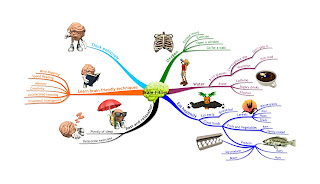Tuesday, January 24, 2012
Mind Mapping for Focus
For anyone who finds planning, memorizing, or making decisions a little daunting, mind maps make this process easier. Mind mapping is similar to brainstorming or outlining ideas, and has been shown to improve memory, solve problems, and help people understand and organize large chunks of info. This technique can help make connections between two dissimilar topics, which can add depth to your subject.
If you're a writer, or have a writing assignment, mind mapping may also help you write faster, break through writer's block, or even come up with a topic. Research has shown that students can perform 10% better on tests and assignments when they use mind mapping. You can also use these for your daily life, career planning, or work assignments. Basically, mind maps help you in any area where you need to organize more than a couple basic pieces of information.
These are easy to make. To start, simply write your primary topic on a blank sheet of paper. From this primary topic, draw lines (arrows, boxes, or whatever you desire) to the important categories. Draw pictures next to them if you'd like; this can help with memory.
Begin making subtopics under the categories. Brainstorm, use free association, and don't be afraid to include silly things. Add more categories and subtopics as necessary. This is for your use only. You're finished when you can think of nothing else to add, though you'll often find that if you come back to what you've done, you'll have more to add.
Once you're finished, you can rewrite it neatly or color code the whole map. Review what you've written, and give some thought to the conclusions you've come to. If you still feel overwhelmed, put the map aside and come back to it in a few hours or the next day.
It's important not to let the mind map stall your progress. Once you've created one and you know where to go, be sure to act on it! Make a plan of action or to-do list. Don't let your hard work be for nothing.
You can choose to make your mind maps in your journal, or another place you know you will refer to frequently. Or you can write them on whatever scrap paper is close to hand and file them away. I print a lot of sheets, and I like to do mine on the back of these. Recycling. Sort of.
Another tip: to place completed maps in a three ring binder so that you'll know exactly where to find them for later use.
Mind maps are an excellent way to generate a lot of ideas without being hung up on structure. Once you finish, you can review everything you wrote, then focus on creating something using your strongest ideas.
Tags:
Brainstorm,
Knowledge Creation,
Knowledge Management,
Mind Map,
Mind Mapping,
Paper,
Time management,
Topic–comment
Subscribe to:
Post Comments (Atom)

Hi,
ReplyDeleteI've just discovered your blog. There are great articles here. Will keep you in my short list and will continue to come to visit you. Would you be interested, I have also a blog about digital mind maps here http://www.drawmeanidea.com.
Mind mapping has helped many individuals who seek a more logical and systematic way of organizing ideas to help draw conclusions or understand certain correlations. The good thing about mind mapping is that it can be used for a variety of purposes. One just has to know the relevant facts for him/her to be able to construct a well-thought mind map.
ReplyDeleteAlexandra Gale
Digital Mind Map: Mind Mapping For Focus >>>>> Download Now
ReplyDelete>>>>> Download Full
Digital Mind Map: Mind Mapping For Focus >>>>> Download LINK
>>>>> Download Now
Digital Mind Map: Mind Mapping For Focus >>>>> Download Full
>>>>> Download LINK 9q